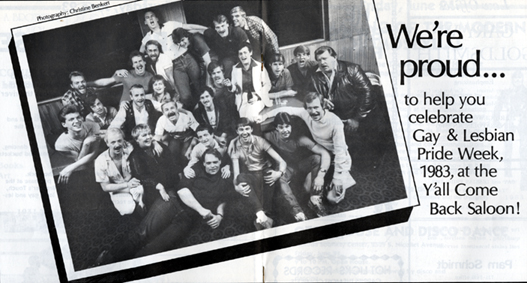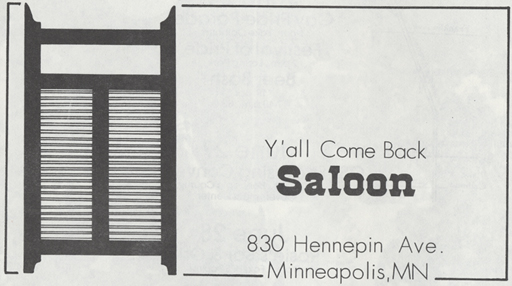The Saloon
830 Hennepin Avenue, Minneapolis
Advertisement from the 1982 Twin Cities Pride Guide. Courtesy of the Jean-Nickolaus Tretter Collection.
One of the most popular sites in Twin Cities LGBT history is, by all accounts, housed in one of the most nondescript buildings on Hennepin Avenue. Built in 1903, 830 Hennepin Avenue predates the small section of 9th street north of Hennepin—its western façade originally bordered another building and was never intended for public view.(1)
Luck and circumstance ushered the Saloon to 830 Hennepin in 1977, when Ernest Pesis, owner of Sutton’s Place, opened the "Sondown Saloon" at its present location.(2) “Andy” Anderson and John Moore purchased the venture in 1981, and recieved full ownership one year later. The two met in Loring Park in 1972, shortly before joining F.R.E.E..(3)
| The dance club originally operated across the street from the Adonis/Flick Theaters at the time.(4) After paying off thousands in surprise debt and back taxes, they set about investing their profits in the “Y’all Come Back Saloon.” | 
|
The Saloon immediately drew a younger crowd of queer men—this visible draw occasionally encouraged the perpetrators of hate crime violence to attack club goers. On New Year’s Eve, 1981, Rick Hunter waited for his partner John Hanson to pick him up outside of the Saloon after closing time. Hunter observed two young men harassing passersby and, eventually, the two attacked him and his lover on 9th Street.
Police quickly entered the scene and, upon a shout from Hanson at his attackers, beat the victims.(5) The attack was a visible addition to years of police brutality—at their trial, Hanson and Hunter were acquitted of wrongdoing.(6) Events such as these inspired better police training and the Queer Street Patrol.
The dance club eventually dropped much of its western décor and became what many called it, simply “The Saloon.” By 1994, Andy and John already boasted “the best light and sound system in the Twin Cities,”(7) and the Saloon’s reputation as a preferred dance space continues to attract queer men and their admirers.
This entry is part of:
Minneapolis/St. Paul, MN: 100 Queer Places in Minnesota History, (1860-2010)
(1)According to A City of Minneapolis Map in 1917, available in the Records management division of the Old Minneapolis Courthouse/City Hall.
(2)Ritter, J.C. "Saloon's Roots dates to 1972 Gay Murder in Loring Park." Equal Time, 4/2/1986. Page 9.
(3) Ibid.
(4)Twin Cities Pride Guide, 1977. Saloon Advertisement, page 9.
(5)Campbell, Tim. “Saloon Bouncers Charge Police With Brutality after ‘Gay Bashing’” The GLC Voice: Vol.3 Issue 5, 1/4/1982.
(6)Campbell, Tim. “Jury Acquits Hunter and Hanson of All Wrongdoing.” The GLC Voice: Vol. 3., Issue 15, 6/7/1982.
(7)Mattheson, “Bright Lights, Bar Nights.” Gaze Magazine, Issue 217: May 27, 1994. Page 35.
